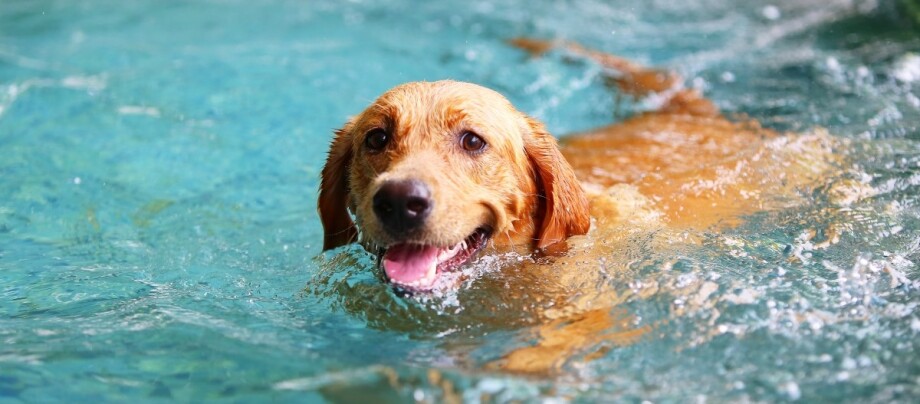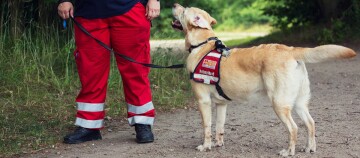Take your dog swimming: Holidaying by the water’s edge
26.06.2024 - Reading time: 4 minutes

Wasitt/iStock / Getty Images Plus via Getty Images
In summer, dogs enjoy nothing more than cooling off in water. And swimming is not only a welcome respite from the heat, but also excellent muscle training. We have put together some helpful advice to ensure your dog enjoys their day by the sea, river, or lake.
General guidance for swimming with a dog
The guidance for dog swimming is similar to humans: When it’s hot, dogs should not jump straight into cold water and swimming on a full stomach is not recommended. Don’t underestimate the strength of sunlight reflected through the water, and protect dogs that have thin or short coats by applying special dog sun cream. The amount of time your dog should spend in the water depends on how well your four-legged friend swims, as well as how old and how fit they are. But even a young, healthy, regular swimmer should rest in the shade after 20 minutes – even if they don’t want to! For older dogs, swimming is a gentle muscle-building exercise. Take particular care not to overexert your pet, even walking in hip-deep water offers sufficient muscular exercise for a senior canine.
What is swimmer's tail?
Swimmer’s tail or limber tail is a very painful condition affecting the base of the tail and surrounding nerves. Sometimes referred to as acute caudal myopathy, it often occurs after prolonged bathing in cold water. The clearest sign of the condition is the position of your dog’s tail: horizontal for a few centimetres and then slightly bent towards the ground. Swimmer’s tail is very painful and must be treated by a vet.
Have fun, but be safe: Life jackets for dogs
Swimming is not only a great exercise but also means you can spend quality time with your dog. Take fun to the next level with floating toys for them to retrieve – or, for more advanced dogs, weighted dummies for diving. Buying a life jacket is recommended.
Many dogs overexert themselves in the water – especially when playing with toys – and cannot accurately assess their strength. A life jacket can also improve your four-legged friend’s swimming technique. Many dogs swim with their body deep in the water and an overstretched neck. This can lead to excessive pressure on the lower spine. A life jacket helps your dog achieve better buoyancy so they float more horizontally on the water. Make sure the jacket fits well and that the buoyancy cells are positioned around the abdomen. As your dog uses their tail to steer, the vest must keep the base of their tail free.
There are other rules to consider when swimming in seawater. Try to prevent your pet from swallowing large amounts of seawater, as it can lead to diarrhoea and stomach cramps. Take enough drinking water to the beach. Rinse your dog thoroughly with fresh water after they have been swimming to avoid any skin irritation.
How to plan for a dog friendly beach day
Playing on the beach has its pitfalls because sand can feel like sandpaper on wet dog paws. Check your dog’s paws regularly and rinse them thoroughly when you leave. On the beach, protect your dog (and yourself) from the sun by using sun cream or a shady windbreaker. After swimming, don’t forget to look after your dog’s ears: Dry their ears thoroughly with an absorbent cloth. If you don’t dry them carefully moisture can lead to inflammation, particularly in dogs with floppy ears.
Safety first: 4 tips for swimming with a dog
A self-appointed four-legged lifeguard
Some dogs have the urge to save their owner when in the water: Your four-legged friend can become anxious if they can only see your head. They may swim up to check on you and can cause painful scratches and bruises on your body. So, what can you do? If your dog is wearing a life jacket, grip the vest to keep them at a distance. This works best if you can still stand on the seabed. Calmly bob up and down and praise your dog when they start to control their swimming. Getting them involved in a game can also help, for example using a floating toy. After a while, your dog will realise you are not in distress. Staying calm and a being patient are important – panicking and pushing them will escalate the situation.
Letting your dog cool off – away from the sea or lake
Letting your pet paddle in a cool body of water can be refreshing for your four-legged friend. Help your dog cool down when temperatures rise with our top tips.


